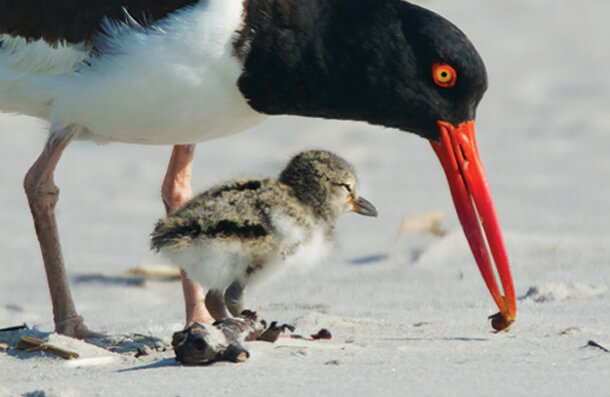Beachgoers Asked to "Fish, Swim, and Play from 50 Yards Away"
Newly Hatched Birds Face Dangers at Every Turn
Robert Johns: 202-888-7472, Email click here

American Oystercatcher, Elliotte Rusty Harold/Shutterstock
(Washington, D.C., June 29, 2015) As millions of vacationing Americans head to their nearest beach destination for surf and sun this summer, American Bird Conservancy (ABC) is urging beachgoers to be mindful of the many beach-nesting birds that will be tending to their nests and newly hatched young.
“Young birds have a tough go of things during their early days, so they really need our help. They face being trampled by unaware beachgoers, run over by motorized vehicles, or killed by predators. Even people simply getting too close can cause nest abandonment,” said Kacy Ray, Gulf Conservation Program Manager for ABC's Gulf Beach-Nesting Bird Conservation Program.
"The best thing for beachgoers to do is to avoid getting close to areas where larger congregations of birds are gathered, and to always respect areas that are roped off or marked with signs designating an area that is used by nesting birds,” said Ray. “The habitat for these birds is diminishing every year due to beach development, erosion, and ever-increasing recreational use, so we have to be mindful that while the beach is a place where we recreate, it is also a place they depend on to survive. They have no other place to go.”
Ray pointed out that it can be difficult for both the year-round resident and the casual vacationer to see the difference between a bird that is simply sitting on the sand and one that is tending eggs, a nest, or young.
“You know you've entered a nesting area when large groups or individual birds vocalize loudly, dive-bomb your head, or feign injury to lead you away from their nests. If this happens, back away and share the beach so the birds can successfully rear their young,” she said. Ray said that most nesting birds tend to use higher parts of the beach away from the surf, so it should be possible to avoid conflict with beach nesters so long as people remain close to the water and away from the dunes or higher areas.
There are special concerns for different regions of the country:
Gulf Coast
Least Terns and Black Skimmers nest in colonies along the Gulf Coast. Wilson's and Snowy Plovers and American Oystercatchers can also be found in this region but tend to be spread out in more isolated single-pair territories along the coast.
ABC is leading a Gulf Coast conservation effort that is working to identify and implement protective measures for these vulnerable beach-nesting birds. The project utilizes expertise not only from ABC but from partners throughout the Gulf region, including U.S. Fish and Wildlife Service, Houston Audubon, Coastal Bend Bays and Estuaries Program, Audubon Louisiana, Bon Secour National Wildlife Refuge, and Eckerd College in Pinellas County, Fla., among others.
Funded by the U.S. Fish and Wildlife Service and other private donors, the project focuses on protecting and monitoring beach-nesting bird habitat in Texas, Louisiana, Alabama, and Florida. It also includes statewide public awareness campaigns in Texas and Louisiana asking boaters, fishermen, and other recreationists to “Fish, Swim, and Play from 50 Yards Away” from birds nesting on islands and beaches. Regional partners in this effort include Barataria-Terrebonne National Estuary Program, Gulf Coast Bird Observatory, and Coastal Bend Bays and Estuaries Program.
“It takes a lot of feet on the ground to raise awareness about birds nesting and raising their young on beaches. This year ABC and its partners are working in the Tampa Bay region, Gulf Shores, Ala., and all up and down the Texas coast to help these birds and their young,” said Ray.
Atlantic Coast
The federally threatened Piping Plover can be found on Atlantic Coast beaches extending from North Carolina to Maine. They are especially concentrated along the northeastern coast, notably along the beaches of Long Island, N.Y., and the southern Delmarva Peninsula. Other species include the Least Tern, Black Skimmer, American Oystercatcher, and Wilson's Plover.
Pacific Coast
Western beaches host populations of the federally threatened “Western” Snowy Plover, endangered "California" Least Tern, and the Black Oystercatcher (which is more frequently found on rocky, rather than sandy, beaches). While the terns tend to be colonial in their nesting habits, the plovers are more spread out, often favoring sites where rivers enter the ocean.
#
American Bird Conservancy is the Western Hemisphere's bird conservation specialist—the only organization with a single and steadfast commitment to achieving conservation results for native birds and their habitats throughout the Americas. With a focus on efficiency and working in partnership, we take on the toughest problems facing birds today, innovating and building on sound science to halt extinctions, protect habitats, eliminate threats, and build capacity for bird conservation.


















































